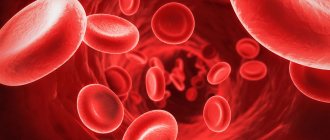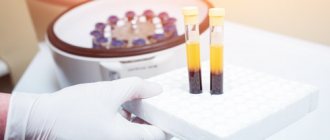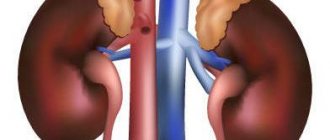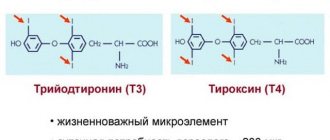What is estradiol?
Estradiol is produced in women by the ovaries (most of them) and the adrenal cortex. This hormone is produced under the influence of FSH (follicle-stimulating hormone), LH (luteinizing hormone) and prolactin. In addition to the formation of the female reproductive system and the regulation of menstruation, estradiol affects the growth of the uterus during pregnancy, regulates the activity of the sebaceous glands and the formation of subcutaneous fat in women. This female hormone is also involved in the formation of bone tissue, has an anabolic effect and lowers cholesterol levels.
Estradiol in the body of women
In women, the production of estradiol depends on the phase of the menstrual cycle. Thus, under the influence of luteinizing and follicle-stimulating hormones of the pituitary gland, estradiol begins to be produced by the ovaries and cells of growing follicles in the first phase of the cycle in small quantities. In addition, it produces estradiol and adipose tissue. Gradually, the concentration of the hormone increases and by the time of ovulation it triples. In the second - luteal phase of the cycle - its level decreases again, reaching the initial level by the beginning of menstruation. Throughout the entire period, estradiol is also processed into other types of estrogens - estrone and estriol.
In addition, estradiol affects the regulation of the rhythm of menstruation, the secretion of secretions from the cervix, and is responsible for the growth and “preparation” of the inner lining of the uterus - the endometrium - for embryo implantation. After pregnancy, its concentration gradually increases, and after a few weeks the function of estradiol formation passes to the placenta. By childbirth, the concentration of the hormone in the blood becomes maximum, and after it decreases to standard numbers. By menopause, its level gradually decreases and after its onset becomes minimal. Estradiol also affects the formation of secondary sexual characteristics in women. Under the influence of the hormone they:
- the timbre of the voice rises
- the figure takes on feminine features as a result of the appearance of fat deposits in the subcutaneous tissue - the breasts increase, the buttocks and hips are rounded
- hair appears in the groin and axillary areas
- sexual desire appears
- the skin becomes smooth and thin
In addition, estradiol:
- affects blood cholesterol levels and increases blood clotting
- activates metabolic processes in bone tissue and enhances its growth
- promotes water and sodium retention in the body
- improves mood
For women, the doctor may recommend undergoing a study to determine the concentration of estradiol if:
- menstrual irregularities
- decreased fertility
- lack of ovulation
- hypofunction of the gonads
- dysfunctional bleeding from the uterus
- premenstrual syndrome
- pituitary insufficiency
- osteoporosis
- preparation for IVF
- tumors of the ovaries and adrenal glands
- polycystic ovary syndrome
- infertility
- suspicion of the appearance of tumors secreting estrogens
- assessment of the functioning of the fetoplacental complex during pregnancy
Preparing for the test for estradiol hormone
To determine the level of estradiol in a woman’s body, venous blood is needed. The patient is warned that blood is taken in the morning, on an empty stomach. The break after the last meal should not be less than 8 hours. On the eve of the day of blood sampling, it is important to avoid physical and psychological stress, as well as drinking alcohol and fatty foods. The patient should tell her doctor about taking any medications, as a number of medications can interfere with the test results. Smoking is prohibited at least one hour before the test.
Causes, symptoms and treatment of low estradiol
The most common cause of low estradiol levels is taking medications, including oral hormonal contraceptives and chemotherapy drugs. Most often, such an adverse reaction occurs with the following drugs:
- Dexamethasone;
- Pravastatin;
- Mifepreston;
- Cimetedin;
- Danazol;
- Nafarelin.
Also, a decrease in the amount of estradiol in the blood can be caused by a high-carbohydrate or low-fat diet, vegetarianism, alcohol abuse and menopause. Among the diseases that most often lead to a decrease in this indicator, it is necessary to highlight polycystic ovary syndrome and chronic inflammatory diseases of the reproductive system.
Symptoms of low estradiol in the blood are the following:
- acne on the face;
- dry skin;
- constant feeling of fatigue;
- feeling of coldness in the upper and lower extremities;
- swelling;
- baldness;
- the appearance of hair on the face, chest, abdomen and buttocks;
- disruption of the menstrual cycle;
- anovulatory cycle;
- infertility;
- tendency to diarrhea;
- soreness of the mammary glands;
- insomnia or drowsiness;
- irritability;
- decreased sex drive.
Diagnosis and treatment of estradiol deficiency in women is carried out by a gynecologist together with an endocrinologist.
Treatment for low blood estradiol in women of childbearing age is hormone replacement therapy. Estrofem, Proginova, Estradiol and Estraderm TTS 25 are highly effective in this case.
In addition to drug therapy, experts recommend following a diet with a predominance of protein foods and intensifying your sex life.
Estradiol hormone is the norm in women
The level of this hormone in women’s bodies changes during different phases of the menstrual cycle. In the first half of the follicular phase, estradiol is reduced. This happens until the middle of this phase of menstruation, then gradual growth begins. Estradiol reaches its maximum twice during the menstrual cycle. The first time is an hour before the peak of LH production, and the second time the maximum level of estradiol is observed on the ninth day after the release of the egg (ovulation). In addition, at different stages of pregnancy, the rate of estradiol will also change.
I would also like to note that reference values in different laboratories will differ. The analysis should always be deciphered by a specialist.
The relative values of estradiol norms for women in relation to various phases of the menstrual cycle and pregnancy are given below.
| Category | Estradiol norm |
| Follicular phase of the menstrual cycle | 50-482 pg/ml |
| Ovulatory phase of the menstrual cycle | 66-488 pg/ml |
| Luteinizing phase of the menstrual cycle | 51-376 pg/ml |
| Menopause | 6-53 pg/ml |
| Pregnancy 1st trimester | 510-6300 pg/ml |
| Pregnancy 2nd trimester | 2400-18900 pg/ml |
| Pregnancy 3rd trimester | 11900-37100 pg/ml |
Causes and symptoms of deviations
When assessing the results of the analysis, it is important to take into account the period of the menstrual cycle and the woman’s age. During menopause, the ovaries and adrenal glands function less actively, and the production of hormones, including estradiol, decreases. During pregnancy, the values of the most active steroid hormone increase, which is normal.
READ ALSO: The estrogen hormone estradiol is increased in women: reasons and methods for normalizing indicators
A gynecologist should figure out why estradiol levels are higher or lower than standard values. During the diagnostic period, consultation with a qualified endocrinologist is often necessary.
The effect of estradiol and progesterone on the body during infertility
If a woman suffers from infertility, then in addition to follicle-stimulating and luteinizing hormone, her levels of estradiol and progesterone are also determined. Increased testosterone and androgens can also affect estradiol.
Estradiol plays a great role in metabolism in the body. Its deficiency during menopause causes calcium to be washed out of the bones and leads to osteoporosis. It has a beneficial effect on blood cholesterol levels, which are lower in women than in men. And with the onset of menopause, blood cholesterol increases, which contributes to the development of atherosclerosis and can provoke a heart attack or stroke.
Causes, symptoms and treatment of elevated estradiol
Estradiol levels above normal are observed during pregnancy. But also high levels of this hormone can be a consequence of various diseases, namely:
- benign and malignant neoplasms of the ovaries;
- polycystic ovary syndrome;
- hyperthyroidism;
- obesity;
- liver failure;
- chronic alcoholism;
- neoplasms of the mammary glands.
In addition, elevated estradiol levels are often observed as a side effect of certain medications, including hormonal oral contraceptives, anticonvulsants, and fungicides.
You can suspect an increase in estradiol in the blood based on the following signs:
- periods that are too short or long;
- painful periods;
- acne;
- increased sensitivity and soreness of the mammary glands;
- sleep disturbance;
- headache;
- hair loss;
- emotional lability;
- intestinal dysfunction.
Treatment is primarily aimed at eliminating the cause, but if the estradiol level is not normalized, then hormonal drugs are prescribed. It is also important to normalize your daily routine, get enough rest, protect yourself from stress and eat right.
Watch the video about estradiol.
source
Normal amount of estradiol
Estradiol in women is measured in picograms per 1 ml of blood plasma. There are no average indicators. All values depend on the age of each specific girl and her characteristics. In addition, the substance content may vary over a range of values due to the influence of:
- cycle phases;
- pregnancy;
- smoking;
- chronic overexertion and stress;
- drug treatment;
- climate and its sudden changes.
So, depending on the age and condition of the body at the time of the study, the normal values will be the following:
- in newborns the amount of estradiol will be 0;
- in girls aged 4–6 years, the norm is considered to be up to 22 mg/ml;
- in adolescence, the normal amount is in the range of 25–30 pg/ml;
- in the first half of the menstrual cycle – 57–227 pg/ml;
- at the time of ovulation, the amount of estradiol is 127–476 pg/ml;
- in the second half of the menstrual cycle – 77–227 pg/ml;
- during pregnancy, the normal amount will be 210–27,000 pg/ml;
- the amount during menopause is 19–82 pg/ml.
Hormone levels are increased
When the level of this hormone in a woman’s body increases, the following symptoms will appear:
- Unreasonably rapid weight gain increases - with the same diet and the absence of new dishes in the diet, a woman will rapidly gain kilograms.
- There are abundant acne on the skin , which worries not only a teenage girl during puberty and formation, but also a mature woman.
- Rapid fatigue also manifests itself , the constant cold of the hands and feet bothers us - unpleasant numbness of the limbs, constant cold even on a hot day shows itself.
- Worrying about the irregular menstrual cycle - this is the most characteristic sign for this pathological condition.
- Swelling and hair loss are another negative cosmetic sign of decreased levels of this hormone.
- Excessive sensitivity and tenderness of the breast , gastrointestinal disorder.
- Irritability and increased nervousness , sleep disturbances and attacks of muscle cramps.
Causes
Among the reasons why the hormone may increase, doctors identify the following:
- Obesity. It is adipose tissue that acts as an endocrine organ, and if there is an excess of it, the level of the hormone estradiol will naturally increase.
- Hyperandrogenism is a condition in which male hormones predominate in a woman’s blood. Since the latter act as precursors of female estrogens, this causes an increase in estradiol.
- Ovarian tumors provoked by a hormonal imbalance - cysts and other neoplasms in the ovaries also provoke an increase in estradiol.
- Damage to many diseases of the liver - cirrhosis and other lesions of this important organ provokes a disruption of metabolic processes, the removal of excess hormones from the body.
- Long-term use of a number of medications , most often containing hormones.
- Passion for alcohol , especially beer, rich in hops and plant female hormones.
- Diagnosing a malfunction of the endocrine system - the thyroid gland and other internal secretion glands involved in the production of hormones.
Treatment
The course is prescribed exclusively by a doctor - a woman is prohibited from practicing independent treatment or taking certain medications. Therefore, before starting treatment, it is important to undergo an examination and diagnosis by a gynecologist.
The course of treatment is selected individually and consists of the following points:
- First of all, taking medicinal formulations that contain plant-based female hormones. Such drugs and complexes should only be prescribed by a doctor - you should not practice independent herbalism, even if you consider yourself to be experts in this field. A large amount of plant hormones is found in clover and alfalfa, beans and licorice root.
- The next important step is to restore normal functioning of the gastrointestinal tract , since it is through the stomach that excess hormones are eliminated. In your diet, you should include mandatory consumption of fiber and foods high in lengan. Flax seeds and bran, greens and oatmeal, Jerusalem artichoke and yoghurt.
- In the diet, it is important to reduce the consumption of carbohydrates, supplying them exclusively with vegetables and fruits - it is important to achieve an increase in proteins in the body of omega-3 fatty acids.
- To correct weight, sufficient physical activity , playing sports, or at least maintaining an active lifestyle is important; walking more is recommended.
- A decrease in the level of estriol in the female body occurs under the influence of vitamins, macro and microelements, as well as antioxidants . That’s why it’s so important to introduce daily consumption of fish into your diet, preferably sea fish, and drink 2-3 cups of green tea.
Hormone levels are reduced
Doctors most often diagnose decreased levels during menopause, although these pathological processes can also be provoked by other underlying causes.
But the symptoms will show themselves as follows:
- A gradual decrease in the frequency of menstruation, up to its complete cessation.
- Profuse sweating and an attack of rapid heartbeat in a woman.
- Even with minimal stress, physical and mental, one feels chronic fatigue and migraine attacks.
- Problems with concentration and memory also manifest themselves negatively, and depression manifests itself.
- Cardiovascular pathologies worsen, and excessive dryness of the vagina and skin, accompanied by itching and burning, manifests itself.
During menopause, hormone levels should be monitored regularly, taking tests and relieving negative symptoms with replacement therapy.
Causes
The following reasons are identified:
- First of all, excessively low, or even more precisely, pathologically low body weight has a negative effect on the level of the hormone estriol. If you follow strict diets and food restrictions, nervous stress, or for other reasons, a woman can suddenly lose weight - all this negatively affects hormonal levels and the functioning of internal organs and systems.
- Strong experiences and stressful situations also have a negative effect on the normal levels of the hormone in the blood. As a historical example, during the period of world wars the birth rate of the population will drop sharply. This is due to the fact that, under the influence of emotional stress, a woman’s body produces less hormones, menstruation stops and, accordingly, the likelihood of conception decreases.
- Climax. During this period, all reproductive functions of the female body will gradually fade away - the menopausal period most often begins at the age of 45-55 years and its processes are irreversible. So, during menopause, the ovaries lose their sensitivity to hormones and, accordingly, the synthesis and production of each and every sex steroid decreases.
- Hyperprolactinemia – or pituitary tumor. In this case, negative, characteristic symptoms may appear in the form of interruptions in the menstrual cycle and milk production outside the lactation period, headache attacks and the appearance of body hair. The tumor is diagnosed using MRI or CT, and based on the diagnostic results, surgical treatment is prescribed.
- Failure in the functioning of the ovaries. Most often, doctors put at the top of the list the so-called resistance and exhaustion syndrome (RSS, SES), which provokes disruption of the menstrual cycle. In the case of the development and diagnosis of SOC, the ovaries will develop normally, without deviations, they also produce and grow follicles, but the brain will not respond to all hormonal changes. In the case of SIJ development, the woman has a similar condition, but the follicles either do not develop or they are few in number. In addition to this, symptoms of menstrual irregularities and other signs of the onset of menopause are added to the pathological condition.
- Hypopituitarism is a complete or partial loss of all functions of the pituitary gland. This phenomenon can occur for a variety of reasons, and most often doctors identify - brain tumor and infectious diseases, radiation exposure.
- Another common cause of this pathological condition, in which the level of estriol decreases significantly, doctors call genetic disorders in the structure of DNA . As doctors note, a healthy woman has 46 chromosomes, which determine her appearance and body structure, ability to bear and give birth to a baby, and other anatomical features. Often chromosomes can be grouped incorrectly, and this provokes the appearance of various syndromes. The course of Shereshevsky-Turner syndrome - in a woman, genetic studies and analyzes show 45 chromosomes. The diagnosis is most often made already in the maternity hospital - based on characteristic external signs.
The norm and deviation from it
The ideal situation is when the amount of female hormone is balanced by the amount of testosterone. But as we know, the level of estradiol is always different and is influenced by too many factors: age, menstrual phase, pregnancy. The highest level of hormones will be immediately before ovulation and during pregnancy. The value can range from 210 to 2700 pg/ml. The hormone will reach its maximum level at the time of childbirth, after which it will gradually decrease. At the beginning of the cycle, estradiol levels will vary from 57 to 227 pg/ml. Increased rates are observed in young girls during puberty. By the time a woman goes through menopause, these levels approach a minimum. The normal level of the hormone estradiol in menopausal women can range from zero to 54 pg/ml.
Analyzes
The analysis helps to identify many pathological processes.
Preparing for analysis
To obtain accurate results, it is important to prepare in advance for the test.
- First of all, a few days before the test, stop drinking alcohol and don’t be physically or emotionally overtired, follow a diet, eliminating fatty, fried, and spicy foods from your diet.
- If the patient takes medications, undergoes a course of treatment with biotin - the test is taken 8-9 hours after taking the drug.
When to take it?
Doctors call the following indications for taking this test:
- Irregularities in a woman's menstrual cycle when infertility is diagnosed.
- For complete control of drug-induced ovulation during the course of IVF fertilization.
- When diagnosing neoplasms in the ovaries.
- If the woman has previously been diagnosed with osteoporosis.
How is the analysis done?
Let's look at how the analysis itself works and simple rules on how to take it.
- The test itself is taken on the 6-7th day of the start of menstruation, in the morning - 8-10 hours, on an empty stomach - before donating blood for testing, you are only allowed to drink water.
- Blood is taken from a vein in a laboratory and immediately submitted for testing.
- Results are given the next day.
Correcting hormone levels
There are several methods for correcting the level of estradiol in the blood. First of all, only a gynecologist and endocrinologist will help normalize the hormone level, who comprehensively select a course of treatment based on test results.
Types of therapy:
- If the symptoms of menopause are pronounced , drugs containing estradiol are most often prescribed, which are prescribed according to the contraceptive regimen for 1-3 months. Such drugs are produced in the format of tablets and ointments, glues and patches, vaginal suppositories - choosing an effective format is not difficult, taking into account the individual characteristics of the body.
- When diagnosing premenstrual syndrome and after undergoing surgery to remove the ovaries, doctors recommend taking a course of oral estrogen-progestin contraceptives.
- When a woman is diagnosed with a true form of post-term pregnancy , which provokes a decrease in the level of the hormone estradiol in the blood, Proginov or another drug is prescribed to stimulate labor.
- In case of delayed sexual development in a teenager , as well as in case of insufficiency of the hormone estrogen in the body, it is practiced to take a course of hormonal medications containing this hormone. The dosage in this case is 1-2 mg and the course of administration is no more than 3 weeks with a week break, lasting up to six months.
- When diagnosing the development of a benign/malignant tumor in the pelvic organs and systems, surgical removal or a course of chemotherapy, radiation or other therapy are used, respectively.
source












